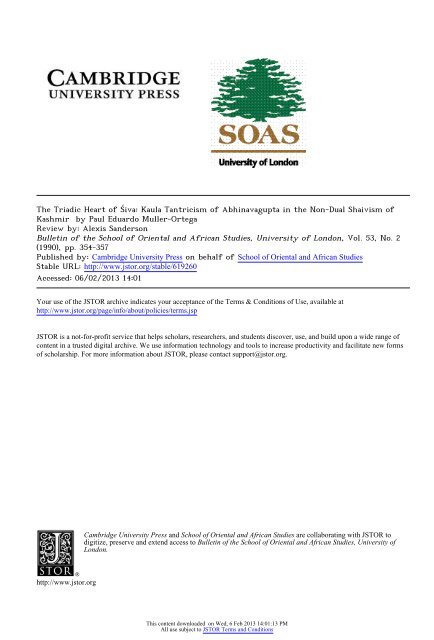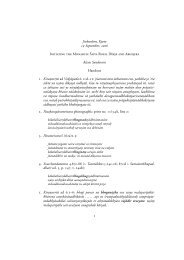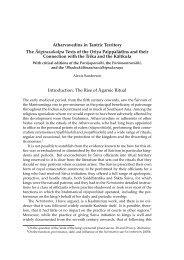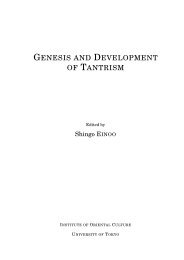Review of: Paul Eduardo Muller-Ortega, The ... - Alexis Sanderson
Review of: Paul Eduardo Muller-Ortega, The ... - Alexis Sanderson
Review of: Paul Eduardo Muller-Ortega, The ... - Alexis Sanderson
You also want an ePaper? Increase the reach of your titles
YUMPU automatically turns print PDFs into web optimized ePapers that Google loves.
<strong>The</strong> Triadic Heart <strong>of</strong> Śiva: Kaula Tantricism <strong>of</strong> Abhinavagupta in the Non-Dual Shaivism <strong>of</strong>Kashmir by <strong>Paul</strong> <strong>Eduardo</strong> <strong>Muller</strong>-<strong>Ortega</strong><strong>Review</strong> by: <strong>Alexis</strong> <strong>Sanderson</strong>Bulletin <strong>of</strong> the School <strong>of</strong> Oriental and African Studies, University <strong>of</strong> London, Vol. 53, No. 2(1990), pp. 354-357Published by: Cambridge University Press on behalf <strong>of</strong> School <strong>of</strong> Oriental and African StudiesStable URL: http://www.jstor.org/stable/619260 .Accessed: 06/02/2013 14:01Your use <strong>of</strong> the JSTOR archive indicates your acceptance <strong>of</strong> the Terms & Conditions <strong>of</strong> Use, available at .http://www.jstor.org/page/info/about/policies/terms.jsp.JSTOR is a not-for-pr<strong>of</strong>it service that helps scholars, researchers, and students discover, use, and build upon a wide range <strong>of</strong>content in a trusted digital archive. We use information technology and tools to increase productivity and facilitate new forms<strong>of</strong> scholarship. For more information about JSTOR, please contact support@jstor.org..Cambridge University Press and School <strong>of</strong> Oriental and African Studies are collaborating with JSTOR todigitize, preserve and extend access to Bulletin <strong>of</strong> the School <strong>of</strong> Oriental and African Studies, University <strong>of</strong>London.http://www.jstor.orgThis content downloaded on Wed, 6 Feb 2013 14:01:13 PMAll use subject to JSTOR Terms and Conditions
s s s s j s ]t . dS, r . . . r. . .Kashmir.From ch. iv to ch. ix, the last, <strong>Muller</strong>-<strong>Ortega</strong>considers the nature <strong>of</strong> the Trika's conception<strong>of</strong> the Heart as the Absolute, the methods <strong>of</strong> itsrealization, and the nature <strong>of</strong> that realization.In the fourth chapter he shows the connexionsbetween the concept <strong>of</strong> the Heart and those <strong>of</strong>(i) the omnipresent centre (madhya) and (ii) thecoessentiality <strong>of</strong> prakasa and vimarsa. He givesno translations <strong>of</strong> these latter terms, butglosses them as ' the primordial light beyondand behind all manifestation, ... bothtranscendent . . . as well as immanent . . . in itsmanifestation' (p. 95) and 'the capacity <strong>of</strong>consciousness to be conscious <strong>of</strong> itself (p. 96).In his handling <strong>of</strong> this pair, which he refersto collectively (prakasa-vimarsa) as ' theself-reflecting illumination' (p. 95), he followsthe late Harvey Alper (Journal <strong>of</strong> IndianPhilosophy, 7, 1979, 345v07), explainingAbhinavagupta's doctrine <strong>of</strong> appearance-inand-<strong>of</strong>-consciousness(abhasavada) as anattempt to find a middle way between thedoctrine <strong>of</strong> real transformation (<strong>of</strong> one intomany) (parinamavada) and that <strong>of</strong> merelyapparent change (vivartavada), which wasmotivated by a desire ' to encompass withoutreconciling-contradictions, that is, to befaithful to the confusion <strong>of</strong> experience, to beconsistent in inconsistency' (Alper, op. cit*, atp. 98). Abhinavagupta would have beenstartled by the implication that he consideredit impossible to give an entirely coherent andrational account <strong>of</strong> fundamental realityChapter v examines passages which equatethe Heart with the cosmic totality (kula), withthe all-encompassing triads characteristic <strong>of</strong> theTrika, with the (sexual) union <strong>of</strong> Siva and hisPower, and its replication in the sexual ritual <strong>of</strong>Kaulism. Chapter vi moves on to two otherfundamental and related concepts: (i) that <strong>of</strong>vibration (spanda), and (ii) that <strong>of</strong> ' emissionalpower' (visarga). Chapter vii looks at someother ' natural metaphors' <strong>of</strong> the Heart, particularlythe sky, the abyss, the ocean, the waveand the AHAM (' I ') which, through crypticsemantic analysis <strong>of</strong> its constituent letters, isshown to be the system's Absolute in its all-tlXlVU6ll 11sO llVW UWWl-aD"WtO } D Wlilkilgenerates that concealed light which has fivefaces', as though the text read -rucijanakah.Even if this were an attested variant it wouldhave to be rejected as unmetrical. Furthermorehe translates as though his new compound withits nom. sg. masc. ending qualified the neuternoun yamala which occurs in its stem within acompound in the following verse-quarter.Equally bizarre is his rendering <strong>of</strong> abhinavasrstimahayananl in the preceding verse-quarter (i.e.' the " mother ' whose effulgence [mahas] is inthe primal emission ') as ' producing the greatand quite new manifestation'. Finally, he takesthe main verb <strong>of</strong> the verse to be a noun. <strong>The</strong> lastverse-quarter reads hrdayam anuttaramrtamayammama samsphuratat, i.e. ' May myheart, which embodies the supreme nectar,%ullyexpand.' <strong>Muller</strong>-<strong>Ortega</strong> has ' My heart . . .because <strong>of</strong> its quivering and throbbing [mytalics], is the supreme immortal group (kula).'Evidently he has taken the imperative samsphuratatas the ablative singular <strong>of</strong> a (nonexistent)action-noun samsphgrata.Such errors are not isolated freaks. <strong>The</strong>y teemin his translations, including that <strong>of</strong> theParatrlsikalaghuvrtti in the appendix. Indologistsand students <strong>of</strong> religion should be warnedagainst quoting these translations or using themas the basis <strong>of</strong> argument.Nor can the reader be always sure what theauthor is translating. <strong>The</strong> edition <strong>of</strong> theParatrlsikalaghuvrtti which he has used is that<strong>of</strong> the Kashmir Series <strong>of</strong> Texts and StudiesNo. 68. Yet under references to that edition hesometimes quotes passages which diverge fromit; and he does so without comment or explanation.This is the case at, e.g. p. 257, n. 39 quotingp. 10, 11. 5-8; p. 279, n. 18 quoting p. 19, 11. 13-17; and p. 261, n. 17 quoting p. 5, 11. 2s22. <strong>The</strong>third <strong>of</strong> these quotations is less problematic,because he turns out to be following variantsproposed by Rafaele Torella (Rivista degli StudiOrientali, 53, 1979, 178-9), but this fact is notmentioned.Where the Paratrzsikalaghgvrtti is quoted inchs. i to ix such divergences can at least beobserved. But the complete translation in theappenc 1X 1S glVeIl US without the original. Thatencompassing circularity. Chapter viii turns to here too the reader must be on the look out forthe Heart as mantra, i.e. to the symbolism <strong>of</strong> divergences is signalled from the start by histhe syllable SAUH Chapter ix considers the translation <strong>of</strong> the prose introducing the iirstpresentation <strong>of</strong> the Heart as the state <strong>of</strong> verse. <strong>The</strong> Sanskrit <strong>of</strong> the edition is ...realization attained.svatmadevataiva ... svatmanam paramarsam-<strong>The</strong> work contains many passages in transla- senavatarantam prechati, i.e. ' It is the deitytion (with the Sanskrit given in the endnotes). constituting one's own [true] identity who asksHis principal source, as already mentioned, is the question [and asks it] <strong>of</strong> itself [when it seesthe Paratrlsikalaghuvrtti; but he has drawn itseli] descending through its aspect <strong>of</strong> selfwidelyon the Kashmirian Saiva literature, par- expression.' <strong>Muller</strong>-<strong>Ortega</strong> has '... the Godticularlyon Abhinavagupta's other major dess ... reflects and questions herself incessworkson the Trika: the Tantraloka, the antly. ' This does not register the edition's parti-Tantrasara, the Malinlvijayavartikand the ciple avatarantam (' descending ') and gives anPara trimsikavivarana .adverb ' incessantly' to which nothing in theThis is a brave attempt to make sense <strong>of</strong> edition corresponds. I suspect, therefore, that hedifficult materials. But it is also a somewhat was reading anavaratam for avatarantam. <strong>The</strong>refoolhardy one, since the author's Sanskrit is not iS, <strong>of</strong> course, no way <strong>of</strong> determining the sourceyet ready for it. This will be sufficiently evident <strong>of</strong> this variant. <strong>The</strong> author may simply havefrorn three examples drawn from his rendering misread the text, or he may have emended for(p. 87) <strong>of</strong> the prayer with which Abhinavagupta reasons good or bad.opens his Tantrdloka, Tantrasara, MalinlvEjaya- Given his inadequate grasp <strong>of</strong> the language <strong>of</strong>vartika and Paratrimsikavivarana. Firstly he his sources the author has done surprisinglytranslates pancamukhaguptarucir janakah (i.e well. On the whole he has managed to convey' the " father" whose radiance is preierved the general outline and tone <strong>of</strong> Abhinava-This content downloaded on Wed, 6 Feb 2013 14:01:13 PMAll use subject to JSTOR Terms and Conditions
o suKEV1EWSness so Inal Iney appear more accesslole to tnehas gone into this study, sustained by an evident imagination. I shall give two examples <strong>of</strong> thepersonal enthusiasm for Abhinavagupta's reli- first tendency and one <strong>of</strong> the second.gious vision. <strong>The</strong>re are, however, numerous (i) Pp. 167-170 deal with initiation (dlksa).errors over particulars. Some <strong>of</strong> these he has <strong>Muller</strong>-<strong>Ortega</strong> says here that a detailed discusinheritedfrom the works <strong>of</strong> other scholars in the slon <strong>of</strong> this topic is precluded by the variety <strong>of</strong>field. Examples are the view that the these rites, but gives one passage in translationParatrlsika/-trimsika is part <strong>of</strong> the (Tantraloka 23.33-39) which, he says, ' des-Rudrayamalatantra (pp. 6 and 42), and that cribes a rather advanced initiation for theAbhinavagupta's ' spiritual search ' led him to empowerment <strong>of</strong> a new teacher, in which thetravel outside <strong>of</strong> Kashmir and that finally, in transmission <strong>of</strong> a mantra plays a crucial role'Jalandhara, he encountered his guru (p. 167). However, this passage does not des-Sambhunatha (p. 45). Both views go back to cribe an initiation <strong>of</strong> any kind. Its subject is theK. C. Pandey (Abhinavagupta, 1963 [2nd ed.]: mantra-observance (vidyavrata) which is to be4$5 and 45-7) and both are without founda- performed by a newly consecrated <strong>of</strong>ficianttion. <strong>The</strong> first proceeds from the occurrence <strong>of</strong> (acarya, guru) before he is able to initiate others.the word rudrayamalam in the last verse <strong>of</strong> the <strong>Muller</strong>-<strong>Ortega</strong>'s translation turns this into a riteParatrlsika (evam mantraphalapraptir ity etad <strong>of</strong> initiation by inserting a reference to anrudrayamalam/etad abhyasyatah siddhih initiand where there is none in the Sanskrit:sarvaCnatvam avapnvyat//). However, it refers ' . . . the teacher must recite the mantra . . . <strong>The</strong>not to the text <strong>of</strong> the Paratrlsika but to the mantra then reaches the disciple's heart' (sasyllable SAUH taught in it, as is particularly guruh [3 la] . . . japen mantram [34d] . . .obvious from the expression which follows, i.e. anabhikuharantaram [36b]). It is his own heart' Anyone who persistently practises this will that it reaches.attain success . . .' <strong>The</strong>re may be no reference to (ii) On p. 164 we read: ' <strong>The</strong> guru is alwaysthe Rudrayamalat all here, the word meaning taken to be Siva incarnate by reason <strong>of</strong> hissimply 'the union <strong>of</strong> Siva (Rudra) and his condition <strong>of</strong> enlightenment. ' He holds, in otherPower (Rudra)' (see Paraitrimsikavivarana words, that all gurus were believed to bep. 178, ll. 4-5). <strong>The</strong> short commentary, enlightened. Neither Abhinavagupta nor anyhowever, does take it to refer to the Tantra <strong>of</strong> other author <strong>of</strong> this tradition held this extrathatname, but as follows: ' Thus one can obtain ordinary view. No such claim is made, even forfrom this supreme seed-syllable all the benefits the gurus <strong>of</strong> the elite Kaula form <strong>of</strong> the Trika.<strong>of</strong> mantras, i.e. the higher and the lower accom- Indeed Abhinavagupta refers explicitly toplishments. This is why it is this [syllable] that is Kaula gurus who have not attained enlightenthe[true] Rudrayamala; for since Siva and his ment (Tantraloka 29.129: apraptavibodhah)Power are eternally fused in it, it has the teaching the manner in which they are to do thecapacity to bestow all that may be bestowed by fixed rites (nityakarma) before they proceed tothe Rudrayamala [proper] with its 12,500,000 carry out a rite <strong>of</strong> Kaula initiation.verses. '<strong>Muller</strong>-<strong>Ortega</strong>ppears to be blind to the factAs for the travels in search <strong>of</strong> spiritual that the enlightened guru represents an idealenlightenment which K. C. Pandey attributed to rather than the norm even in such esotericizingAbhinavagupta, there is not a shred <strong>of</strong> evidence forms <strong>of</strong> Saivism as the Trika. <strong>The</strong> norm is theand Pandey <strong>of</strong>fers none. This does not prevent initiated (ksita) and consecrated (abAisikta)him from saying that they occurred. <strong>The</strong> but unenlightened performer <strong>of</strong> Siva-directedculmination <strong>of</strong> his supposed wanderings in the rituals, the karmin. <strong>The</strong> enlightened ' gnostic 'sacred site (p.tha) <strong>of</strong> Jalandhara, where he met (jeanin) who claimed to have needed no rites forSambhunatha, is evidenced 'beyond doubt' his own liberation nor resorted to them for the(op. cit., p. 12), and this, it seems, is enough to liberation <strong>of</strong> others may have become the soullend plausibility to the whole story. <strong>of</strong> Saivism in Abhinavagupta's presentationUnfortunately the evidence quoted by K. C. but its body was still a system <strong>of</strong> rites in thePandey and there is no other says only that hands <strong>of</strong> ordinary <strong>of</strong>ficiants.Sambhunathachieved celebrity from that site; (iii) On pp. 137 and 138 <strong>Muller</strong>-<strong>Ortega</strong> interseeTantralokaviveka on 1.213.prets Abhinavagupta's doctrine <strong>of</strong> the threeOther errors are <strong>Muller</strong>-<strong>Ortega</strong>'s own. Alote, emissions (visarga) ( Tantraloka 3.211-2 19).for example, his assertion that the letter <strong>The</strong>se are the anava (=cittavisranti), the saktaanusvara represents the finite knowing subject (= cittasambodha), and the sambhava ( = citta-(pramat,r) (p. 126), when in fact it is identified pralaya), so called because they are proper towith the infinite knowing subject (parapramatr, the three ascending but coessential aspects <strong>of</strong>Siva). See, e.g., Jayaratha on Tantraloka consclousness which constitute the Trika's most3.111: asmaddarsane bindur vidikriyayam basic triad: the individualized, contracted conparapramatrekarupahparamesvarah sivah; on sciousness (anu or nara), Power (sakti) and Siva3.112-l 13b: bindur vedayEta parah prakasah. (/Sambhu). He presents them to us as ' threeSome <strong>of</strong> these errors are <strong>of</strong> a deeper kind. levels <strong>of</strong> meditative absorption'. Of the first<strong>The</strong>y are perhaps connected with the very stage he says that it is that 'in which theenthusiasm for the spirituality <strong>of</strong> Abhinava- meditator reposes in consciousness, cittaguptawhich has motivated this study. <strong>The</strong>re is a visranti'. He explains: ' <strong>The</strong> term visrantitendency to underestimate the role <strong>of</strong> ritual as repose, is significant. It denotes an effortlessopposed to meditation or ' enlightenment resting <strong>of</strong> consciousness in itself, alert, yetexperience' and consequently to be under- undirected, so that the current <strong>of</strong> consciousnessinformed about this very important component may cause it to drift slowly inwards. This culmi<strong>of</strong>his subject. <strong>The</strong>re is also a tendency to nates in an inner vacuity which Abhinavaguptaembroider or window-dress Abhinavagupta's calls ' the fire <strong>of</strong> emptiness ' (sunyatanala).'references to functions or states <strong>of</strong> conscious- Now he presents this picture <strong>of</strong> the meditator'sThis content downloaded on Wed, 6 Feb 2013 14:01:13 PMAll use subject to JSTOR Terms and Conditions
* .r r * r ar 1 . * r , , 1 rr v r w7evident meaning <strong>of</strong> the text before him or atUV96llllk W1 tllk 61119W lllVUbO V1 WVbllltlUllnamely, the root, centre and summit (bodh-least that <strong>of</strong> its commentary.In fact it is iargelyamula, bodhamadhya,and bodhagra).This pass-concocted. Its very basis which his imaginationage, which Jayaratha gives in full in his com-embellishes, namely, the view that Abhinava-mentary, is closely parallel to the passage <strong>of</strong> thegupta is speaking about some kind <strong>of</strong> introver-Tattvarak$avidhana whichAbhinavaguptative meditation here, is opposed by the contextquotes as his scriptural authority for this teach-and contradicted by the explanation <strong>of</strong> theing <strong>of</strong> the three emissions (Tantraloka3.215-passage given by Jayarathain the only surviving219). But there is this difference, that while thecommentaryon the Tantraloka.According toTattvaraksavidhana'saccount <strong>of</strong> cittavisrantihim (Tantralokaviveka2 [3] 201-203) this citta-(/anavavisarga)unfortunately undetailed, thatvisrantis not an inwardly directed resting <strong>of</strong><strong>of</strong> the parallel ' root <strong>of</strong> cognition ' (bodhamula)consciousnessin itself but exactly the opposite,in the Trisirobhairavatantranot. It is definednamely, consciousness coming to rest in theas 'dualistic awareness which represents thedifferentiated perception which characterizes[universe <strong>of</strong> the] thirty-six tattvas as outside itsthe finite knowing subject (anu, nara). Whereidentity, and memory [or imagination] whose<strong>Muller</strong>-<strong>Ortega</strong> reads introversion Jayarathacontent is [experienced as] reality vividly distinctreads 'the outermost limit <strong>of</strong> extroversion'[from the self], [in short the individual subject(ibid., 203, 1. 2: bhedaunmukAyepara ka$tha).known as] the limited knower.' (Tantra-This 'emission' is 'that proper to thelokaviveka,5. [8]. ll, ll. 7-8: sattrimsattattva-individual' (anava) precisely because it isvisaye yad bAedenavikalpana/smrtEhsusphuta-characterizedby this gross projection <strong>of</strong> multi-bhedatmamitamatatad ucyate//).plicity in consciousness(ibid., 203, 11. 3X: ...Thus <strong>Muller</strong>-<strong>Ortega</strong> is wrong, it seems, tobhedapradhanyadanavo narasambandhl...take Abhinavagupta's citta-visrantias a state <strong>of</strong>sthulo visargah).As for the ' fire <strong>of</strong> emptiness'introversion. But more reprehensible is the factthis is taken not as ' the fire which is emptiness',that having decided that this admittedly prob-as a state <strong>of</strong> inner vacuity produced by medi-lematic verse refers not only to a state <strong>of</strong>tation, but as this same state <strong>of</strong> extroversion.Itintroversion but also to a meditation leading tois fire-likein the sense that it causes the dissolu-it he then goes on to invent precise details <strong>of</strong> thistion <strong>of</strong> the contentlesstate which precedesit inmeditation, talking in seductively mystical tonesthe natural cycle <strong>of</strong> cognition (ibid., 202, 11. 11-<strong>of</strong> undirected alertness, <strong>of</strong> consciousness drift-12: sunyata bhavaksayatmakamniskalamrupaming slowly inwards.tasya anale tadvilapakatvattadviruddhenikhiieALEXIS SANDERSON(Read nikhila-?)bhavamayesakale rupe). <strong>The</strong>relevant verse <strong>of</strong> the Tantraloka(3.211) is readby Jayaratha as follows: ' <strong>The</strong> anava emission[the emission proper to the individual]is thatHEINZ BECHERT(ed.) and KLAUSbeginninglessfunction [<strong>of</strong> consciousness]in theWILLE(comp.): Sanskrithandschrif-fire <strong>of</strong> emptiness, whose purpose is to projectten aus den Turfanfunden.Teil 6.the state <strong>of</strong> immanence[characterizedby theDie Katalognummern1202-1599.duality <strong>of</strong> subject and object].' This ' transla-tion' can certainly be questioned. Abhinava-(Verzeichnis der Orientalischengupta's Sanskrit here is far from transparent:Handschriften inDeutschlandpurvam visrSyasakalamkartavyamsunyatanale/Bd. x, 6.) [xiii], 243 pp. Stuttgartcittavisrantisam.jno 'yam anavas . . .,andFranz Steiner Verlag WiesbadenJayaratha'sreadingis certainiy rather strained.A more naturalinterpretationwould be: ' FirstGmbH, 1989. DM 160.[consciousness] having emitted the state <strong>of</strong>REINHOLDGRUNENDAHL(comp.): Aimmanence [reading visrSyasakalam] has toconcordance<strong>of</strong> H. P. Sastri's Cata-fashion it in the fire <strong>of</strong> emptiness.' But whetherlogue <strong>of</strong> the Durbar Library and theJayarathais right or wrong in the detail <strong>of</strong> hisinterpretationthe immediate context confirmsmicr<strong>of</strong>ilms <strong>of</strong> the Nepal-Germanthat he is at least right in taking the text to beManuscript Preservation Project.describingthe opposite <strong>of</strong> what <strong>Muller</strong>-<strong>Ortega</strong>[Bound with] HARA PRASADSASTRI:reads, seeing a process <strong>of</strong> filling not emptyingA catalogue <strong>of</strong> palm-leaf and select-consciousness.For the next emission,the sakta,termed ' the awakening <strong>of</strong> awareness' (citta-ed paper MSS belonging to thesambodha)is defined by Abhinavaguptas ' theDurbar Library Nepal, Vol. s and II.condition in what that reality (-tadvastu-),(Verzeichnis der Orientalischennamely, whateverhas been grasped by the eyes,Handschriften inDeutschlandthe ears or any other [faculty], tends toturn inwards to merge with one's self-aware-Suppl.-Bd. 31: Publications <strong>of</strong> theness (212: drstasrutaditadvastupronmukhatvamNepal-German Manuscript Preser-svasamvidi/cittasambodhanamoktahsaktollasa-vation Project, 1.) i-vi, [xi]-cxxix,bharatmakah.//).' ' That reality' can only be that[iii], 771 pp. Stuttgart:Franz SteinerWhiCh iS the content <strong>of</strong> the anava emissionjustdescribed. <strong>The</strong> latter's function then is to pro-Verlag Wiesbaden GmbH, 1989.ject the ' external' reality which the subjecthenSome 25 years after the inaugural issue <strong>of</strong> theinteriorizesthrough cognition. This reading iscatalogue <strong>of</strong> Sanskrit manuscripts from Chinesefurthersupportedby the existence<strong>of</strong> parallelstoTurkestan, Heinz Bechert has taken over thethis cyclical model elsewherein the literature<strong>of</strong>role <strong>of</strong> editor in chief. His introduction sum-the Trika. At Tantraloka8.12-lSb Abhinava-marizes nine decades <strong>of</strong> struggle to exploit thegupta summarises the Trisirobhairavatantra'slegacy <strong>of</strong> the monastic libraries <strong>of</strong> ancientThis content downloaded on Wed, 6 Feb 2013 14:01:13 PMAll use subject to JSTOR Terms and Conditions








